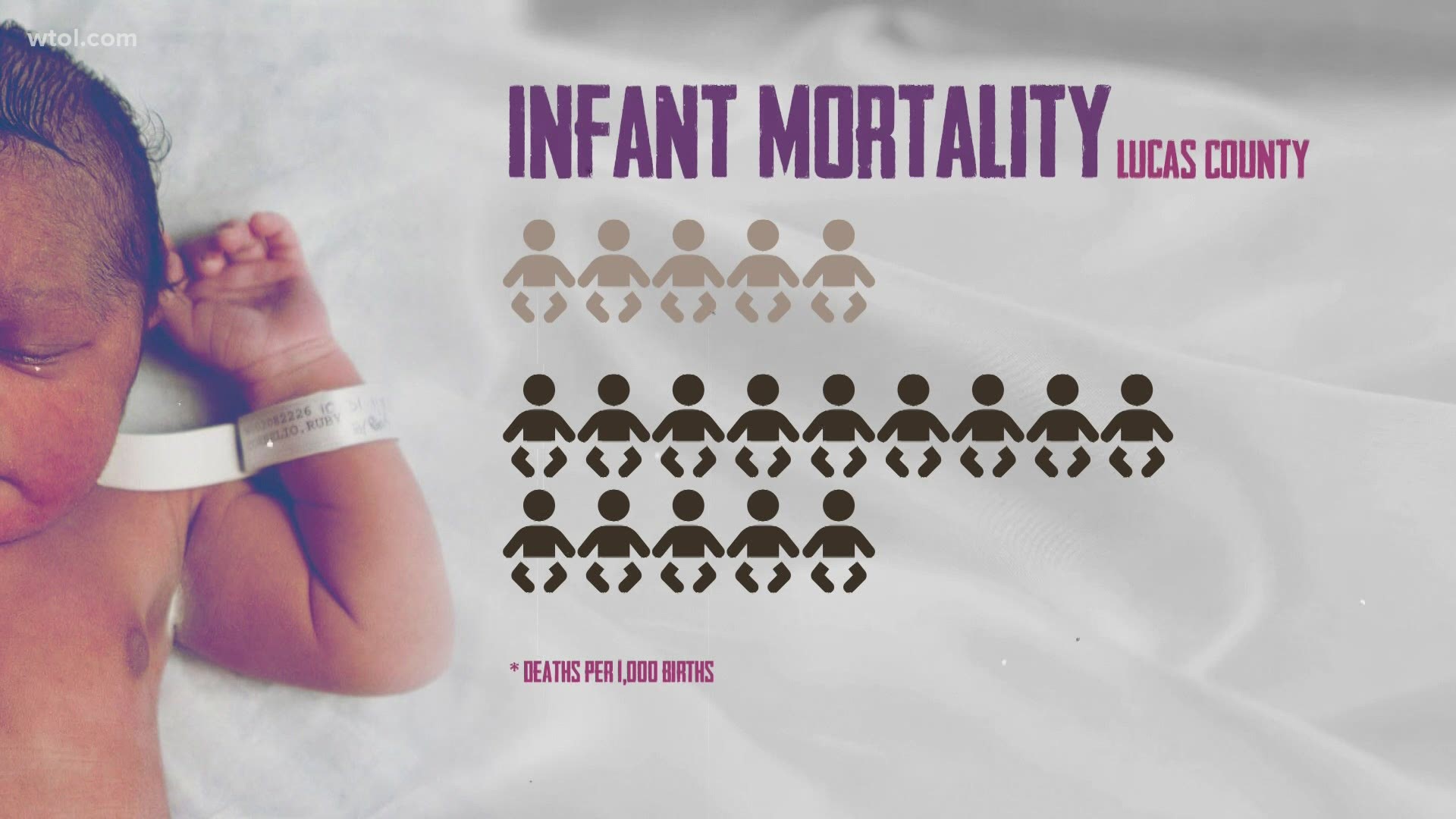TOLEDO, Ohio — It's a big problem in our state and right here in Lucas County: babies are dying before they celebrate their first birthday.
What's more troubling is that in Ohio, a Black infant is nearly three times more likely to die before turning one than a white baby.
"Just another year where we're looking at babies dying and it's a cause for concern," said Toledo-Lucas County Health Commissioner Eric Zgodzinski.
They are words he's uttered far too many times.
Statewide, 929 babies died in Ohio in 2019. That's actually down by about ten babies from the year before, but that's not the trend in Lucas County.
In fact, according to the Ohio Department of Health, the infant mortality rate increased from 7.4 in 2018 to 9.4 in 2019. That means for every 1,000 live births in the county, nearly ten babies died.
When you take a closer look, an even more troubling trend is the infant mortality rate for Black babies grew in Lucas County from 13.7 to 15.9 year over year. Across Ohio, racial disparities continue to widen as well.
In 2019, 518 white babies died, the lowest in a decade, while 356 Black babies died. That means a Black infant in Ohio is now 2.8 times more likely to die than a white baby.
Zgodzinski says, "Those individuals aren't here to be adults and we need to make sure that we're doing everything we can to get that gap narrowed and get as close to zero as possible."
So what's being done to save our babies?
When WTOL 11's Amanda Fay last dove into the numbers nearly three years ago, the Black infant mortality rate was lower at 14.2.
With efforts to reverse that trend, why are the numbers still going in the wrong direction?
Lucas County's Getting to 1 Coalition Program Coordinator Co'Dale Cook says he can't pinpoint one specific reason. "We're still diving into our data to figure out which factors to really focus on so we can really steward our work and target out efforts there," said Cook.
Cook took the position about two years ago and says one thing he's noticed in his time in the role is the lack of consistency with addressing the racial disparity across agencies and organizations working on the issue. He says, "It's not enough to have one conversation. It's not enough to have a conversation about it quarterly. We have to continue these conversations month in, month out. Really, daily."
So what does the Getting to 1 Coalition do? A lot of things, really.
Neighborhood Navigators are like a support system for pregnant and postpartum moms, focused on meeting immediate needs. "So if a woman needs baby items, we will provide referrals to that specific service," explains Cook.
There are also Certified Community Health Workers, like Jada Barnett. WTOL 11 first met her in 2018.
She visits families on a more long-term basis, providing support before women even get pregnant. "Making sure their health, their body, their social, emotional is in place, intact and their bodies are in the best shape possible so that when they do decide they want to start having children, they're able to do so and carry that pregnancy," said Barnett.
RELATED: What's killing our babies
Barnett says as she interacts with families, a big issue she's coming across is confusion. She says, "Families with women not really understanding the different programs that are out in the community and what type of services those programs provide."
Barnett adds that the pandemic is adding more complications to an already delicate situation. "Parents having to be teachers as well as moms, parents running the household, especially if they're pregnant or just delivered a baby. Trying to balance all of those things out."
Barnett says that means many times the last thing a mom wants to do is hop on the phone or Zoom to find out about services and education available to them.
Cook says that's where Getting to 1 has to follow-up. "We can literally lose a client or participant if we don't really focus on our follow-up or be consistent with that," said Cook.
As far as reversing the trend, Cook says while he'd like new programs over time, the biggest thing is focusing on existing programs and its three subcommittees. "We really want to restructure out subcommittees based on what the data is saying. What are the top priority issues that we need to focus on?" explains Cook.
The number one cause of infant death, Cook says, is prematurity. So that means a greater focus on prenatal care and addressing things like mom's age, weight and habits like smoking.
Those are the issues Barnett takes on with her families. And as a mom whose daughter was born weighing less than a pound and is now a blossoming 12 year old, she gets it.
"When I'm helping and assisting, it's not just someone who is trying to collect data on them and reach numbers or whatever, but it is someone who has walked their shoes," said Barnett.
Cook says we all need to talk about racial disparities and social determinants of health in order to really attack this problem. He says, "It's a call to action that our coalition really wants to put out in the forefront. It's a conversation that can't any longer be swept under the rug."
He encourages anyone to ask pregnant women they know about why types of clinical and social services care they're getting and encourage them to call the Getting to 1 hotline at 419-842-0800, or visit the website or Facebook page to get linked up with vital services.
In January, Ohio Governor Mike DeWine announced a new "Eliminating Racial Disparities in Infant Mortality Task Force" would meet for the first time to develop a strategy for reducing infant mortality rates and eliminating racial disparities by 2030.
We're told no one from Lucas County's Getting to 1 Coalition is on that task force.

